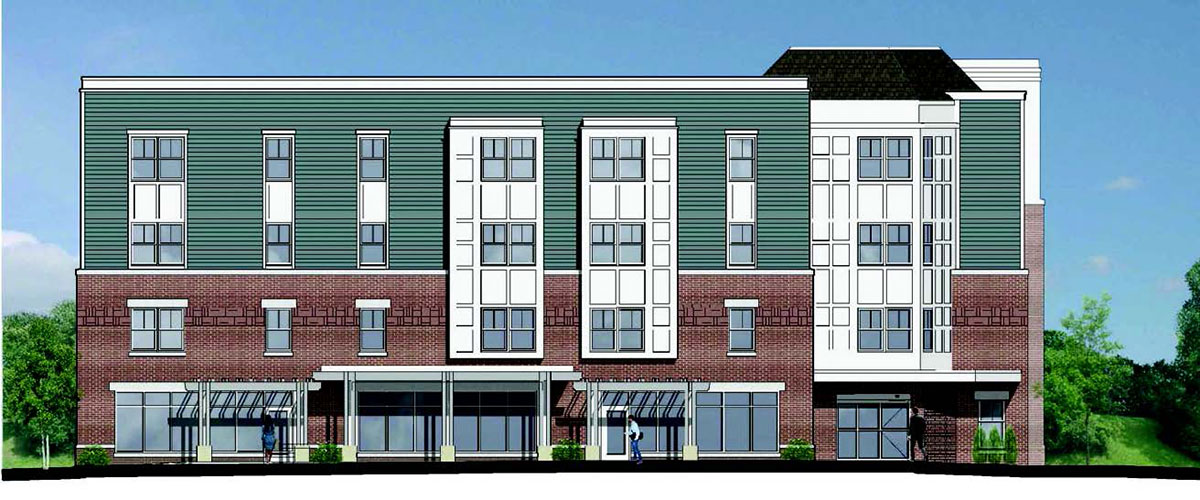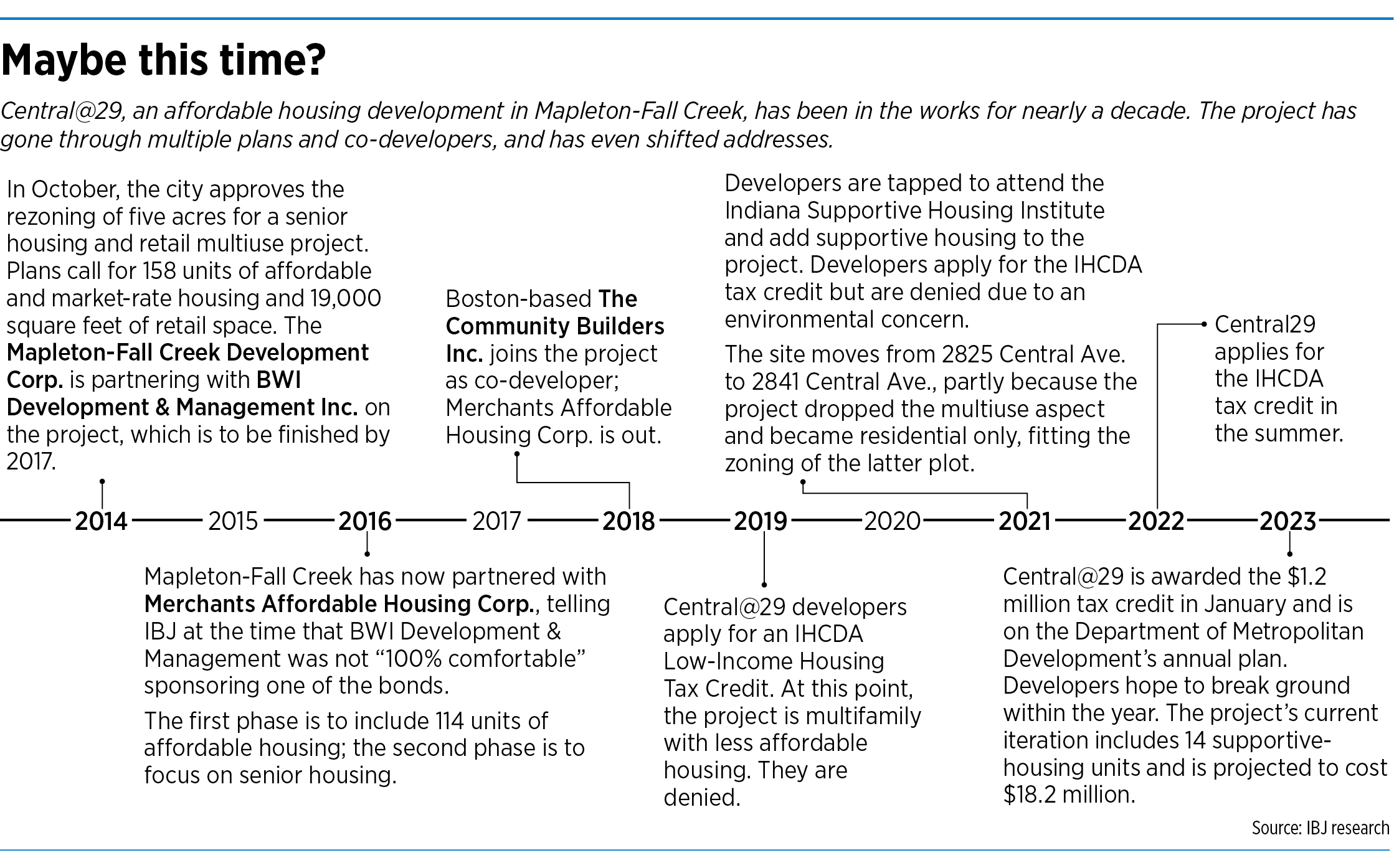Subscriber Benefit
As a subscriber you can listen to articles at work, in the car, or while you work out. Subscribe NowAn affordable housing project nearly a decade in the making might have finally found the right plan and financing to break ground in Mapleton-Fall Creek this year.

After at least four tries, Central@29 has received a low-income housing tax credit from the state. The credit is worth $1.2 million annually for 10 years. Developers and city officials are cautiously optimistic that the project could finally be ready for tenants in late 2024.
“I have a lot of confidence that this project will move forward, and hopefully this year,” said Elan Daniel, CEO of the Mapleton-Fall Creek Development Corp.
The $18.1 million, 56-unit project is planned for the southeast corner of Central and East 29th streets in Fall Creek. The building is slated to be four stories high and include units that range from a 675-square-foot one-bedroom to a three-bedroom with 1,200 square feet. Fourteen units will be reserved for people who are homeless.

Individuals making $19,200 to $51,150 a year and families of four with a household income of $27,400 to $73,050 will be eligible to rent at the property. Raphael Health Center, a faith-based primary care provider, will provide on-site services.
Developments with integrated supportive housing are especially valued in a post-pandemic increase in homelessness. Last year, 1,761 individuals were homeless in Indianapolis, a 12% increase from 2019. But such projects are also difficult to finance, as exemplified by Central@29.
Multiple developers have partnered with the local community development organization and changed the vision of the project in its decade of planning. Since 2018, Boston-based The Community Builders Inc. has been developing the project with Mapleton-Fall Creek Development Corp.
And the low-income housing tax credit was a critical element in moving the project forward.

The federal credits are awarded to the state and then doled out to developers by a state agency such as the Indiana Housing and Community Development Authority. Developers generally sell the credits to private investors to obtain funding.
The tax credits are highly competitive. For every three projects, one is funded, said Jacob Sipe, executive director of the state housing authority. Projects are evaluated by a panel on a point system. Central@29 was denied at least three times.
“It’s not uncommon that a development will have to submit an application a second or third time,” Sipe told IBJ. “We don’t have as [many] credits as we do applications.”
Area amenities, the affordability of the units, how sustainable the financing sources are and how long units will stay affordable are all factors the IHCDA takes into consideration. It also maintains set-aside percentages of credits for large cities, rural areas and permanent supportive housing.
In 2015, the project—then focused on senior housing and mixed-use—was poised to receive a 4% tax credit from the housing authority because it was within a federally defined low-income area. Unfortunately for the project, changing demographics caused the area to exceed the income parameters.
The community development corporation—in partnership with The Community Builders—took another shot at a 9% low-income housing tax credit in 2019. That year, plans called for 15,000 square feet of retail space and a separate 25,000-square-foot food production area, along with single-family houses available for purchase.
The project again was denied funding.
In 2021, the developers were selected to attend the state supportive housing institute, which led to the addition of 14 permanent supportive housing units to the plan. In this application process, the housing authority panel found the project attractive enough to give it a higher score than some awardees, but an environmental concern in the area disqualified it.
Finally, the project was approved for the low-income tax credit in 2022.

“That was kind of the last piece of the puzzle,” Mapleton-Fall Creek’s Daniel told IBJ.
The project is also receiving $3 million from the city to pay for permanent supportive housing services, $1.5 million from the state Housing Trust Fund and a $750,000 loan from the state’s development fund.
Jeff Beam, a developer with The Community Builders, said it often takes a while to match a plan with the parameters of funding sources.
“The funding programs have very specific criteria that they like to award the funding based on,” Beam said. “Those sometimes align well with a community’s vision, and sometimes not.”
Another Indianapolis supportive housing development, St. Lucas Lofts, had a ceremonial groundbreaking this year. The project at East New York Street and Temple Avenue has been in the works for five or six years, said Rusty Carr, interim director of the Indianapolis Department of Metropolitan Development.

Carr said these projects are a three-legged stool, in which developers need funding for the development process itself, funding for services, and funding for rental assistance.
The city also awarded Central@29 a community development block grant. That pass-through federal funding, paired with the project’s inclusion of supportive housing, made the city more committed to seeing it through, Carr said.
“It’s really imperative that the city remain a partner, as long as that development is still alive and moving forward,” he said.
The project would partially help maintain two qualities Daniel said are important to the community: diversity and family.
Mapleton-Fall Creek is gaining homeowners but seeing an increase in white population and a decrease in Black population, according to a 2022 report by the Fair Housing Center of Central Indiana. It’s important to provide affordable housing to the community to maintain the diverse population that makes it unique, Daniel said.
“The area is becoming a desirable area, and as a result, real estate prices have started to accelerate. And because of that acceleration and increasing value, we started to lose some of that diversity that we cherish, especially among the lower incomes,” he said.
The development also includes four three-bedroom units, which can help address the city’s need for adequate space for homeless families.
“We’re trying to create an environment where families can get connected to housing who otherwise wouldn’t have that option,” Daniel said.•
Please enable JavaScript to view this content.

